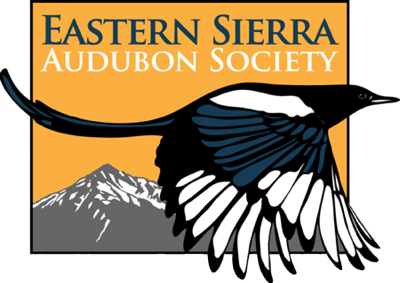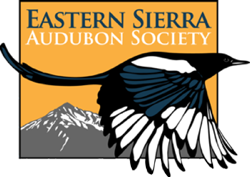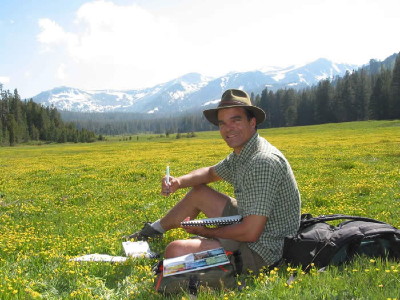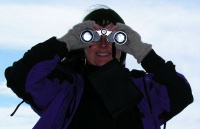

Sierra Wave
Newsletter
Volume 34, Number 4
March-April, 2016
Sierra Wave Newsletter
Volume 31, Number 4
March-April, 2013
Contents
- Events:
- Features:
- News:
- Business
Events
March 3rd: Osprey Research in the Mono Basin with Lisa Fields
Thursday, March 3, 2016, U.S. Forest Service/BLM Building in Bishop, 7:00pm
Our program will be held at the U.S. Forest Service/BLM Building in Bishop on West Line Street, near the DMV. Please welcome our guest speaker, Lisa Fields, who will be giving a presentation on her Osprey Research. Doors open at 6:30, with the presentation starting at 7:00pm.
Osprey Natural History and Research in the Mono Basin

Meet Nigel - ready to transmit data, photo by Lisa Fields
Osprey Researcher Lisa Fields will speak about Osprey natural history including their range, identification, their behavior, and some of the past issues they have faced as a species. Then she will focus on the research that she's been conducting at Mono Lake since 2004. This includes nesting success as well as investigating local and long distance movements through nestling banding and satellite telemetry. Many aspects of this work have been supported by financial support from the Eastern Sierra Audubon Society.
Lisa Fields is an ecologist for the Southern Service Center of California State Parks. She is based in San Diego but works in parks extending from the Mexican border to central California. Her passion is raptor management, particularly the Osprey at Mono Lake. She initiated the nest monitoring program that began in 2004 and the nestling banding program that was started in 2009, and the use of GPS transmitters in 2013 to track migration.
Questions/comments: programs@esaudubon.org; 760-920-8541.
Back to Top
Upcoming ESAS Field Trips and Other Events
 Monthly Bishop Paiute Tribe COSA, Bird Walk and Census Dates:
Monthly Bishop Paiute Tribe COSA, Bird Walk and Census Dates:
2016 COSA Walk Dates:
- January 9, 8:30 am
- February 13, 8:30 am
- March 12, 8:30 am
- April 9, 8:30 am
- May 14, 8:30 am
- Meet at 7:30 these months:
- June 11, 7:30 am
- July 9, 7:30 am
- August 13, 7:30 am
- September 10, 7:30 am
- October 8, 8:30 am
- November 12, 8:30 am
- December - will coordinate with the Bishop CBC for date and time!
[COSA walks are held on the second Saturday of every month, unless otherwise announced]

Winter birding in the COSA
Unless otherwise indicated, our COSA bird walks will all be the second Saturday of the month, except (sometimes) for December, because we will have it coincide with the Christmas Bird Count. During June, July, August, and September they will start at 7:30 instead of 8:30. Watch the monthly email update, this field trips page, or local media for confirmation, updates on leader(s) and meeting time. Or, contact Hillary (below), or if you just show up at 8 or so, you'll probably find us!
The Conservation Open Space Area is being developed for wildlife and the community by the Bishop Paiute Tribe. We'll be keeping species lists and observing behavior as well as identifying birds, for the purpose of creating bird lists for the site. For more information, read this article on the COSA in the March-April 2013 Sierra Wave newsletter. There have been surprises every month so far - come find out what new birds we'll see next time - maybe you'll add toour bird list on e-Bird!
All are welcome - these walks are for birders of ALL LEVELS, beginners included! We will bring extra binoculars and field guides to share. If you'd like to print out a bird checklist, with blanks for adding your own discoveries, you can download that here: COSA Bird Checklist trifold (pdf)
Please meet at 7:30am in June-September, or 8:30am during October-May at the BLM/Forest Service Building on West Line Street in Bishop. Contact Hillary Behr for more information, or if you are interested in leading a future monthly walk: hillarybehr@yahoo.com.
Back to Top
Back to Top
Features
Barred Owl Barges into Inyo County!
[Click on any photo to see larger, or all in a slideshow]

Barred Owl
The Barred Owl is a large owl, only slightly smaller than a Great Horned Owl, with ebony-black eyes. It is a resident of forests, swamps, and riparian habitats and, historically, was widespread in the eastern half of the United States. The northern range began to extend north and west and reached central Canada in the 1880s, British Columbia in the 1940s, the Pacific Ocean by the 1960s, and California on 12 March 1981 in Redwood National Park near Crescent City (American Birds 36:890). See map (below, right) from Robbins, C.S., Bruun, B., and Zim, H.S. 1966. Birds of North America, Golden Press, NY.

From Robbins, C.S., Bruun, B., and Zim, H.S. 1966. Birds of North America, Golden Press, NY
Since then, Barred Owls have moved south along the California coast to Sonoma and Marin Counties and into the California interior along the northern border at Tule National Wildlife Reserve, Siskiyou and Modoc Counties, Nevada and Yuba Counties (north and northwest of Lake Tahoe), and Tulare County (General Grant Grove) through 2004. In 2012, one bird was photographed at Spanish Spring, eight miles NW of Sparks, Nevada (Janice Vitale, et al., North American Birds 67:321), a first record for the state. See map (below, left) from Mazur, K.M. and James, P.C. 2000. Barred Owl in Birds of North America, No. 508 (A. Poole and F. Gill, eds. The Birds of North America, Inc., Philadelphia, PA).
You may question why you are reading this tutorial on the Barred Owl, which has not occured in Inyo County. So glad you asked!

From Mazur, K.M. and James, P.C. 2000. Barred Owl in Birds of North America, No. 508 (A. Poole and F. Gill, eds.). The Birds of North America, Inc., Philadelphia, PA
On 4 February 2016, Jen Scott, an Emergency Room physician at Northern Inyo Hospital, took her break as she usually does by walking in the COSA (Conservation Open Space Area) designed and managed by the Bishop Paiute Tribe. She noticed an owl perched in a tree behind the BLM/Forest Service building and looked hard at it. She knew it was an owl, but she'd never see this species before. She returned to the hospital to get her camera and walked back to the tree hoping it would still be there and she could get some images. It was, and she did. Break time over, she returned to work. It wasn't until the evening she had time to call Nancy Overholtz, whom she had met on birding field trips, and said that she had an owl and didn't know what species it was. Nancy asked if she could send an image, "Yes" said Jen. Nancy opened the image and responded, "WOW!" She checked her field guide to confirm her identification and then sent the image to us for another confirmation. It was an unequivocal image of a Barred Owl. Nancy called Jen and told her, "It's a Barred Owl and it has never been recorded in Inyo County before!" Nancy immediately began calling some local birders to give them the exciting news and suggest that the following morning at 0730 they meet in the parking lot to the COSA.

Jen Scott (center), the original finder, with Ron and Nancy Overholtz
On 5 February, twelve people arrived as the sun rose and quietly and slowly walked through the COSA gate and down the lane to the east and the BLM/Forest Service communications tower. As they closed in on the tree closest to the tower and were able to view the east side where Jen had it perched, disappointed sigh sounds emanated from the group. Jen Scott showed everybody the exact branch it was sitting on, but it was not there this morning. The group dispersed and for the next couple of hours scoured the COSA. The habitat is so extensive and the backs of some of the trees are hidden with other vegetation that the owl could have been there but not visible to all the adrenaline-driven eyes. For another couple of hours the group re-scoured the COSA and expanded coverage into the cemetery with the same results. Not to be deterred, plans were made to again look the following morning. On 6 February, Nancy and Ron have made an early morning survey for the owl part their daily schedule and post daily whether the owl was there or not. On 6 February, they were out first and let everybody know that it was not in its tree. Some birders throughout the day searched and found no owl.
On 7 February, Steve Dickinson refound the owl on the same branch and the call and Eastern Sierra Birds post went out immediately. Sixteen birders arrived shortly and stood in awe as shutters flickered like movie cameras while pixels were collected of the first ever record of a Barred Owl in Inyo County. Based on the shape of the tail feathers, pointed, and pure white, the bird was hatched last spring and is an immature. The bird was not seen 8 February but was there in all its glory on the same branch on the 9th and 10th remaining all day as had been the pattern. On the 9th the Barred Owl was sitting in the large crotch of the tree instead of the left-side smaller branch. No one had any suspicion that something was unusual until it jumped with a clump of feathers hanging from its right foot. The attached object quickly disappeared from view when the owl resettled and began eating, and eating, and eating, and eating. Obviously the intake was more than a small passerine could provide. After almost an hour, the owl hopped over the edge of the crotch, still clutching the carcass and wings slightly open like the owl was screening the booty from our view and quickly jammed it in a small crevice under the crotch. During this quick transfer images were taken with hopes that someone captured something that would identify the entre. Nancy said that she felt it was a Sharp-shinned Hawk but hoped the images would prove it. We sent images with some feathers and legs showing to some top-notch birders and their separate responses were identical 'My gut tells me it is a Sharp-shinned Hawk but I wouldn't bet my life on it!' When top birders all "guess" the same answer, the preponderance of opinions makes calling it anything else absurd. No feathers of the victim have been recovered. The bird continued eating the carcass on the 10th and then was not observed for the next three days.

From the left: Carina and Alex Abella, Nancy and Ron Overholtz, Jim Parker, and Guy McCaskie
Guy McCaskie, the father of avian field observations and record keeping, as are practiced by today's serious birders, came up from San Diego on the chance that it was going to reappear. It took three days but prescient, as he always has been, he saw the Barred Owl on the 14th, his last day. We arrived at the COSA with Guy at 0630 and no owl. Oh, the agony of defeat! We were so disappointed that today wasn't going to be the day. Guy said he wanted to check out the tower to the east to see if he could find the second Peregrine Falcon because he could see one bird and there were two birds previously. We didn’t find a second Peregrine but we did get very close looks at an immature Northern Harrier that didn't mind us coming close to him. Then Guy said he was ready to head home so we made a U-turn and headed back. As we reached the 'T' in the road we heard Guy excitedly say, "There is a bump on that branch!" and then "It's the Barred Owl!!" Ecstatic juices flowed and three oldsters quickly reverted to being youngsters again! Oh Happy Days!! Calls and posts went out and other birders descended to join the party. After an hour, Guy reluctantly said he had to hit the road and beat the traffic home. That is one Valentine's gift that will be forever remembered!
This saga continues and there is much to be learned by this Barred Owl, the southernmost interior record in California, and the first record for Southern California.… so far.
By Tom & Jo Heindel
Return to Top
Bird of the Month
Board Member Santiago Escruceria will be sharing a photo of a different bird each month - and all can be seen at the Bishop Paiute Tribe's COSA - join us there on the second Saturday of each month to see these birds and more! See upcoming field trips here.
Bullock's Oriole
The Bullock’s Oriole is a medium-sized bird with a long tail and a fine pointed bill. It has a distinctive black crown and nape, with an orange eyebrow with a black eye line and lores. The body is orange-yellow with a dark back and tail, and with a white patch on wings. The song is a series of rapid harsh notes mixed with short chattering sounds. Seen at COSA reserve, fairly common in cottonwoods, aspen trees, and open deciduous woodlands.

Bird of the Month for March-April: Bullock's Oriole - photo by Santiago Escruceria
Sources:
- The Sibley Guide To Birds. Second Edition, 2014. Written and illustrated by David Allen Sibley.
- The Stokes Field Guide To The Birds Of North America. First Edition, 2010. Donald and Lillian Stokes.
- Birds Of The Sierra Nevada, Their Natural History, Status, And Distribution. 2013. Edward C. Beedy and Edward R. Pandolfino; Illustrated by Keith Hansen
Back to Top
News
ESAS Members may remember back in 2010, when we hosted John Muir Laws for a special event and an evening program. His publisher, Heyday Books, contacted us with a special offer for ESAS members on his latest book - read more about it below.
Press Release and Coupon for Eastern Sierra Audubon Members:
The Laws Guide to Nature Drawing and Journaling
 BERKELEY, CA . . . A potent combination of art, science, and boundless enthusiasm, the latest art instruction book from John Muir Laws (called “a modern Audubon” by The Washington Post) is a how-to guide for becoming a better artist and a more attentive naturalist.
BERKELEY, CA . . . A potent combination of art, science, and boundless enthusiasm, the latest art instruction book from John Muir Laws (called “a modern Audubon” by The Washington Post) is a how-to guide for becoming a better artist and a more attentive naturalist.
In straightforward text complemented by step-by-step illustrations, The Laws Guide to Nature Drawing and Journaling (Heyday Books, March 2016) includes dozens of exercises to lead the hand and mind through creating accurate reproductions of plants and animals as well as landscapes, skies, and more. Laws provides clear, practical advice for every step of the process for artists at every level, from the basics of choosing supplies to advanced techniques.
While the book’s advice will improve the skills of already accomplished artists, the emphasis on seeing, learning, and feeling will make this book valuable to anyone interested in the natural world, no matter how rudimentary their artistic abilities.
A growing body of evidence demonstrates that spending time outdoors in nature is good for us, and doctors are increasingly “prescribing” time spent outside in nature. Studies show it lowers levels of cortisol and stress, and increases white blood cells – which can help fight cancer and infections.
“Nature journaling trains your eyes to see deeper into the mystery and beauty of the world, and with practice you will also retrain you brain to be able to draw what you see,” explains Laws. “You do not need to start as an artist or a naturalist, but you will become one, and journaling can become a habit that fundamentally changes your life.”
John Muir Laws is a naturalist, educator, and artist, with degrees in conservation and resource studies from the University of California, Berkeley; in wildlife biology from the University of Montana, Missoula; and in scientific illustration from the University of California, Santa Cruz. He is a 2010 Audubon TogetherGreen Conservation Leadership Fellow and has received the Terwilliger Environmental Award for outstanding service in environmental education.
10% Off for ESAS Members: The discount code for Eastern Sierra Audubon members is ESA1NL. Enter it at checkout on the Heyday Books website and receive 10% off The Laws Guide to Nature Drawing and Journaling.
Back to Top
Save the Dates for these Owens Lake Events
Owens Lake 2016 Spring Big Day - Tuesday, April 19th
The 2016 Owens Lake Spring Big Day will be Tuesday, April 19th. We are looking for birders with at least some experience to help out in this intense bird census of Owens Lake. Contact Mike Prather to sign up. Small groups of citizen scientists will join with LADWP staff to spread across the lake and count EVERY BIRD WE FIND. Expect to see over 100,000 birds! Owens Lake is an Audubon Important Bird Area (IBA) with tremendous importance. It hosts tens of thousands of shorebirds and waterfowl and is the largest nesting location for Snowy Plovers in California. Our data collected on Big Days is used by LADWP, State Lands, California Department of Fish and Wildlife, Great Basin Unified Air Pollution Control District, and Audubon in the management and planning at Owens Lake.
To join in, or for more information, please contact Mike Prather at 760-876-5807 or mprather@lonepinetv.com. We will meet at 7AM at the Diaz Lake parking lot three miles south of Lone Pine on Highway 395.
Back to Top
2016 Owens Lake Bird Festival - April 22-24, 2016
Register Early in order to secure the trips you want!
Join Friends of the Inyo and our partners for the second annual Owens Lake Bird Festival in Lone Pine, CA. The festival will celebrate migrating shorebirds as they move between hemispheres at Owens Lake Important Bird Area and will highlight the significance of the Owens Lake story and the return of a threatened habitat.
There are many new additions to this year's festival. Again there will be a Friday evening meet-and-greet reception at the Lone Pine Film History Museum followed by two days of field trips and more on Saturday and Sunday. "Crack of dawn" trips have been added, as well as trips away from the lake, talks on migration and shorebirds, history of Owens Lake, photography trips, geology and more! See the festival website for all the details and registration! See you there.
See the Friends of the Inyo Owens Lake Bird Festival page for more information.
Michael Prather
Back to Top
Scholarships Available for local Graduating Senior High School Students!
 Are you a high school senior (or do you know a senior) who is interested in applying for the Eastern Sierra Audubon Society’s 2016 scholarships? Two $500 scholarships will be awarded, one to a Mono County and one to an Inyo County senior.
Are you a high school senior (or do you know a senior) who is interested in applying for the Eastern Sierra Audubon Society’s 2016 scholarships? Two $500 scholarships will be awarded, one to a Mono County and one to an Inyo County senior.
We are looking for someone who has demonstrated through current study and activities and whose future studies, volunteer work and career ambitions will promote the National Audubon Society’s mission:
“To conserve and restore natural ecosystems, focusing on birds, other wildlife and their habitats, for the benefit of humanity and the earth’s biological diversity.”
You can be studying art, science, education, advocacy, habitat conservation, journalism, literature, law, public policy, environmental justice or outdoor recreation (or maybe something we haven’t thought of!) Volunteer work as a student is a plus, but not a requirement. Qualified applicants are required to attend college/higher education full-time starting in Fall 2016-2017. On-line applications are available at: esaudubon.org/education/scholarships/.
We welcome you to apply for this special opportunity and will be accepting applications until May 12, 2016. Deadline has to be strictly enforced so we can meet our deadlines with your school.
For more information, contact Roberta Lagomarsini: 760-872-7846, scholarship@esaudubon.org.
Good Luck!
Roberta Lagomarsini
Back to Top
May 14th 2016, Annual Audubon Yard Sale
Save the date AND your donations!
The date for the ESAS Yard Sale has been set. Mark your calendars for Saturday, May 14 starting at 7am.
Spring is a good time for cleaning out closets, garage shelves, attics, and finding long forgotten boxes of treasures. It is also a time when the young scholars of Mono and Inyo Counties prepare to head off to a new collegiate chapter. These students will benefit from a boost in funding their endeavors. With that in mind, Eastern Sierra Audubon Society is moving forward with raising money for scholarships to two graduating seniors in 2016.
On Saturday, May 14, 2016, ESAS is holding a yard sale to help fund our scholarships. We are in need of items to sell at the yard sale, so please start settings things aside. Enlist the help of friends and neighbors, too! As time gets closer, we will let you know where and when items can be dropped.
If you have questions, contact Ann Hoffmann at Hoffmann@qnet.com/760-937-1862. Your help is very much appreciated!
All proceeds from the yard sale go to supporting our ES Audubon high school scholarship fund.
Back to Top
Taking Care of Business
Let Your Voice to be Heard!
We want to hear from you!! This short survey (it's only 6 questions, we promise) will provide the ESAS Board of Directors with helpful feedback on what you like most about the Eastern Sierra Audubon society!
Click on this link for the survey.
All answers are anonymous and will only be used to guide the board.
We appreciate your help and feedback!
Back to Top
Welcome New and Rejoining Members
Thank you to the members who recently joined or renewed their membership!
We'd like to take a moment to promote Chapter Memberships: You may not be aware of this, but 100% of Chapter Membership dollars stays locally in the Eastern Sierra, supporting local education, youth, conservation, and programs. If you don't need Audubon Magazine, consider joining or renewing as a Chapter-only member, or better yet, as both Chapter and National! We do get support from National Audubon, as well, so any membership helps, and is money well-spent toward bird and wildlife conservation and education, and we thank you!
Your membership donations help keep this chapter alive. We get 8-10 renewing members a month, and from 3-5 new members. Your membership dues make it possible for us to offer and support great educational and recreational events throughout the eastern Sierra. Thank you!
If you would like to join and help support Eastern Sierra Audubon, there are two ways you can do it:
- Join as a National Audubon Society Member, designating ESAS as your chapter affiliation. Includes Audubon Magazine subscription. This is $20 a year.
- Join as an ESAS Chapter-only Member for $20 per year. 100% of your donation stays here in the Eastern Sierra this way. Your chapter membership is a way to give back, and show your appreciation for all that ESAS does, and to help support our mission locally. Your membership helps pay for scholarships, programs, special events, education programs, research, and more. THANK YOU for your support!
Click Here for a membership form to join or renew!
Join National Audubon - your zip code will associate you with the chapter nearest you.
Back to Top
Keep in Touch!
All of our content is supplied by our awesome members... if you have any ideas about articles you’d like to see, or better yet, if you have anything to share for newsletter publication, whether an article, a news item, update, correction, poem, essay, artwork, photo, field trip report, neat birding experience, letter, etc, please send it, along with any comments or suggestions, to the newsletter
editor. We’d love to hear from you!
Please continue to send contributions to newsletter@esaudubon.org to make sure they get in the monthly email newsletters and on the website.
We send out about one email each month to remind you of upcoming events - if you are not
on our email list, please
add yourself so you don’t miss anything!
Thanks for reading, and happy birding!
Katie Larsen and Maggie Riley, Transitional Newsletter and Web Team!
Back to Top
Calendar for January-February 2015 (and beyond!)
Back to Top
Final Shot: Which Migratory Bird Are You? Take the QUIZ!

Prothonotary Warbler. Photo: Linda Steele/Audubon Photography Awards
Spring migration has begun! Just when it feels like the long winter days will never end, the annual spring phenomenon begins and bird lovers everywhere rejoice. Many birds spend their winters in southern habitats like those of Central and South America, but now we happily welcome them back to their summer homes.
To celebrate this amazing feat of billions of migrating birds, this Audubon quiz will let you know which of these migratory birds you are.
Back to Top





















